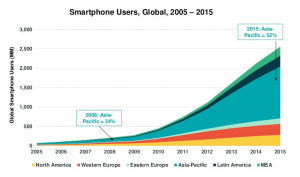
A great mobile strategy starts with understanding the industry.
It’s not difficult to predict that 2017 will be a year of improvements for emerging technologies–autonomous vehicles will become more advanced, virtual reality will reach the mass market, drone usage will grow for both consumers and businesses.
But even with all these new gadgets, some of the most sought-after developments are happening on your smartphone. New and exciting technology is constantly infiltrating the mobile development sector, making the phone the ideal spotlight to grow your business and reach. Here are the top 5 mobile trends you can expect to see this year, and how to stay ahead of the curve.
1) Mobile and tablet devices will make up over 50% of online purchasing.
 This past Cyber Monday because the first instance in which “$1 billion was spent in a single day on mobile devices alone.” Although mobile shopping has only really taken off in recent years, today it is estimated that over 50% of customer purchases are happening on their phone or tablet.
This past Cyber Monday because the first instance in which “$1 billion was spent in a single day on mobile devices alone.” Although mobile shopping has only really taken off in recent years, today it is estimated that over 50% of customer purchases are happening on their phone or tablet.
By 2018, mobile commerce (mCommerce) sales are estimated to reach $626 billion. Not only have the speed and availability of mobile networks grown in the last couple of years, businesses have also seized the opportunity to build mobile-friendly websites, develop consumer-focused apps, improve on engaging customers to turn them into repeat buyers, and capitalize on mCommerce advertising.
In short, mobile shopping has become a highly personalized, at-your-fingertips experience, and shoppers are welcoming the opportunity to make buying easier.
2) Augmented reality is going to be big.
Virtual reality’s little brother augmented reality has been embraced by app developers after Snapchat’s beloved filters’ success and Pokemon GO!’s breakthrough virality. At the height of its popularity, Pokemon GO over passed 100 million downloads and earned over $10 million in one day. By mapping digital images onto the real world through your smartphone’s camera, augmented reality (AR) is cheaper and more accessible than virtual reality. In the long term, companies could start using AR to help customers fix broken products in real time, let customers try on clothing and makeup in their homes, or even provide responsive landscape information for customers looking to remodel. According to Forbes, in the next year we can “expect to see more brands coming out with AR games, AR ads, and attempts to capitalize on AR apps that already exist.”
3) Home-AI integration is on the rise.
Weather your go-to AI assistant is Siri, Cortana, Alexa, or Google Home, we can expect these services to offer more accessories that allow you to digitally control and monitor your living space. There are already “smart” lights, thermostats, and outlets. Home security systems that can be accessed on your phone or through an AI are also readily available on the market.
As these virtual assistants increasingly become commercially successful, you can bet they’ll be plenty of auxiliary purchasables to help make your life more connected. And, as the saying goes, you can be certain that there will be “an app for that.” One way to make sure these AIs will direct their humans to your company is to improve your website’s page rank via SEO. For example, Google Assistant answers your questions using information pulled from the top of its search results, so making sure your business is optimized for search engines is the first step towards connecting with more customers.
4) The anticipated release of the iPhone 8.
Speaking of apps, the next iPhone, to be released later this year, is rumored to include some radical design changes that will revive the stagnant smartphone market, including an edge-to-edge glass display with the home buttons and camera built into the screen. What does this mean for your business? If this new smartphone does bring customers back to the iPhone, one can expect an even higher percentage of more web traffic to go mobile via Apple-specific applications. To stay ahead of the curve, it may be time to start considering what an app could do to increase your business’ sales and productivity.
5) Phone distribution will continue to increase in new markets.

This graph shows how smartphone penetration has increased over the last 10 years. Source: https://goo.gl/2rFMIm
One of the most relevant changes in the smartphone industry of the past five years is that the majority of users are situated in the Asian-Pacific. South Korea has the highest smartphone density of any country–according to NBC, the country has “nearly as many cell phones as people.” This could provide a new market for businesses looking to expand their customer base. Last year, more customers worldwide accessed the web via their smartphone than their computer, and the international penetration of smartphones is projected to continue growing in 2017.
On the other hand, smartphone density in the United States has remained at just below 80% for the past two years. However, another foreseeable area of growth is in rural areas, where Internet access is poised for expansion. It is estimated that “40 million Americans still live in rural areas,” so providing a clean and easy shopping experience for these customers could prove to be lucrative.
Most of these mobile trends point to the same thing: mobile online traffic will be increasing dramatically. One way to stay on top is to refine your mobile strategy for 2017’s unique market by ensuring that your website and eCommerce site are able to can handle heavy mobile traffic. Also consider creating a phone app for your business, allowing your customer to have an easy, enjoyable, engaging interaction with your company’s products and services.

Want to optimize your mobile platform?
Logic Solutions is happy to assist!
Check out what we have to offer in mobile strategy, development, design, and support!
Find your perfect mobile solution

